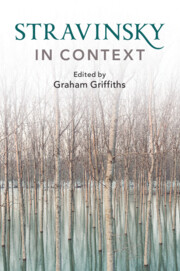Book contents
- Stravinsky in Context
- Composers in Context
- Stravinsky in Context
- Copyright page
- Contents
- Illustrations
- Contributors
- Preface
- Abbreviations
- Frontispiece
- Epigraph
- Part I Russia and Identity
- Part II Stravinsky and Europe
- Part III Partnerships and Authorship
- Part IV Performance and Performers
- Chapter 17 Challenges to Realism and Tradition: Stravinsky’s Modernist Theatre
- Chapter 18 Igor Stravinsky and Ballet as Modernism
- Chapter 19 Stravinsky’s Ear for Instruments
- Chapter 20 Towards a Conductor-Proof Ideal
- Chapter 21 The Pianist in the Recording Studio: Reimagining Interpretation
- Chapter 22 The Legacy of Stravinsky as Recorded History
- Part V Aesthetics and Politics
- Part VI Reception and Legacy
- Recommendations for Further Reading and Research
- Index
- Endmatter
Chapter 22 - The Legacy of Stravinsky as Recorded History
from Part IV - Performance and Performers
Published online by Cambridge University Press: 03 December 2020
- Stravinsky in Context
- Composers in Context
- Stravinsky in Context
- Copyright page
- Contents
- Illustrations
- Contributors
- Preface
- Abbreviations
- Frontispiece
- Epigraph
- Part I Russia and Identity
- Part II Stravinsky and Europe
- Part III Partnerships and Authorship
- Part IV Performance and Performers
- Chapter 17 Challenges to Realism and Tradition: Stravinsky’s Modernist Theatre
- Chapter 18 Igor Stravinsky and Ballet as Modernism
- Chapter 19 Stravinsky’s Ear for Instruments
- Chapter 20 Towards a Conductor-Proof Ideal
- Chapter 21 The Pianist in the Recording Studio: Reimagining Interpretation
- Chapter 22 The Legacy of Stravinsky as Recorded History
- Part V Aesthetics and Politics
- Part VI Reception and Legacy
- Recommendations for Further Reading and Research
- Index
- Endmatter
Summary
In his autobiography the fifty-three-year-old Stravinsky claimed: ‘Composers may well envy the lot of painters, sculptors, and writers, who communicate directly with their public without having recourse to intermediaries.’1 This longing to present a musical work as a self-contained entity, as an objet d’art, became central to his promotion of neoclassical music, and he was most outspoken about this in the article introducing his Octet in 1923, where he stated: ‘My Octuor is a musical object.’2
- Type
- Chapter
- Information
- Stravinsky in Context , pp. 195 - 202Publisher: Cambridge University PressPrint publication year: 2020

